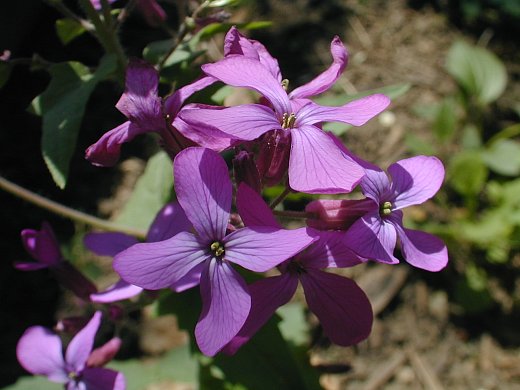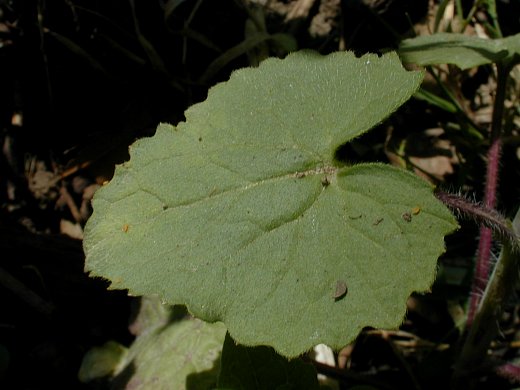Description: This annual or biennial plant is about 2-3½' tall and little branched, except near the apex where the flowering stems occur. The green or reddish stems have scattered long white hairs. The alternate leaves are up to 3½" and 2" across (excluding the petioles). The lower leaves of mature plants are oval-cordate or oval-deltate. They are coarsely serrated or shallowly lobed and have long hairy petioles that are green or reddish purple. The upper leaves of mature plants are deltoid or ovate, somewhat smaller in size, coarsely serrated, and sessile. The basal leaves of young plants are more narrow than the leaves of mature plants. They are lanceolate, narrowly ovate, or oblanceolate, and coarsely serrated or pinnately lobed. There are usually scattered fine hairs that are appressed against the upper surface of the leaves.

The central stem
and upper side stems terminate in racemes of flowers about 2-6" long.
Each flower is about ¾" across, consisting of 4 pinkish purple petals
with branching veins, and 4 oblong sepals that are pink or purple and
appressed together. Sometimes the petals are pink or white, and they
have a tendency to fade in color with age. The slender pedicel of each
flower is about ½" long. The blooming period usually occurs during the
summer and lasts about 1½ months. There is a pleasant floral fragrance.
Each flower is replaced by a seedpod about 1–1½" long that is flattened
and orbicular-oblong. It has a slender stipe adjoining the pedicel,
while its tip has a short slender beak. Each seedpod has a reticulated
outer surface and a few seeds inside. Each flattened seed is
reniform-orbicular with a narrow papery margin. The seedpods become
papery and nearly white with age, and can blow about in the wind, like
the seeds. This plant spreads by reseeding itself.
Cultivation:
The preference is partial sun, moist to mesic conditions, and fertile
loamy soil.

Range &
Habitat:
Apparently, the Money Plant rarely naturalizes in Illinois. According
to official records, it has been found in only Champaign County (see Distribution
Map). However, it is possible that the Money Plant has
escaped from cultivation more often than these records indicate
because it is easy to confuse this species with Hesperis
matronalis (Dame's Rocket). The Money Plant was introduced
into
the United States from Europe as a horticultural plant because of its
attractive flowers and unusual seedpods. Habitats include edges of
woodlands, hedges, and
flower gardens in semi-shaded areas. So far, this plant has not been
invasive of natural areas to any significant degree.
Faunal Associations:
The flowers attract long-tongued bees and butterflies. The caterpillars
of Pieris rapae (Cabbage White) feed on the
foliage. The relationship of this plant to birds and mammalian
herbivores in the midwestern USA is unknown.
Photographic Location:
A flower garden underneath a tree near Urbana, Illinois.

Comments: For a member of the Mustard family, the Money Plant has attractive flowers. The mature seedpods resemble papery coins and are used in dried flower arrangements. Other common names for this plant are 'Honesty' and the 'Silver Dollar Plant.' It is rather easy to confuse the Money Plant with Hesperis matronalis (Dame's Rocket), which is another introduced member of the Mustard family. This latter species is also grown in flower gardens because of its attractive flowers, but it escapes more often into the wild and has become invasive of many natural areas throughout Illinois. The long and cylindrical seedpods of Dame's Rocket, however, have a very different appearance from the seedpods of the Money Plant. Also, the leaves of Dame's Rocket are more narrow and lanceolate in shape. Another introduced species, Lunaria redivida (Perennial Money Plant), is rarely grown in flower gardens in the United States and it has not been observed to naturalize in Illinois. This latter species differs from the Money Plant in having flattened seedpods that are more oblong-elliptical and its leaves are more lanceolate and finely serrated. The flowers of the Perennial Money Plant are often pink, but they can be white or pinkish purple as well.